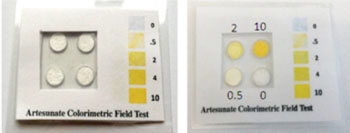Chemical Test Detects Counterfeit Malaria Drugs
By LabMedica International staff writers
Posted on 04 Aug 2014
A rapid, inexpensive and simple colorimetric-based testing kit for the detection of counterfeit anti-malaria drugs has been developed in order to preserve life and prevent the development of multidrug resistant malaria.Posted on 04 Aug 2014
The assay is based on paper microfluidics which offers several advantages over conventional microfluidics, and has great potential to generate inexpensive, easy-to-use, rapid and disposable diagnostic devices and when widely used it could help save hundreds of thousands of lives.

Image: The Artesunate Field Test Kit (Photo courtesy of Oregon State University).
Chemists at the Oregon State University (Corvallis, OR, USA) fabricated a microchip using Whatman filter paper or glass microfiber GF/B (Sigma Aldrich; St. Louis, MO,USA). The filter paper is cut into circular test pads using an 8-mm diameter hole-punch. They designed the paper microchip to enable fluid transport vertically by stacking the paper test pads. Each of the paper cut out has been pretreated by spotting them with different reagents and allowed to dry.
The paper test was divided into layers with the appropriate dried reagents, and the easily prepared sample solution will flow through the regions via capillary action in order to carry out the artesunate detection test. The artesunate sample can then be applied directly onto the test strip/device for measurement. The color will fully develop within minutes so that the user can determine whether artesunate is present in the drug formulation at a therapeutic dose or not. The kit provides a color-coded chart, similar to that accompanying pH paper, which is used to determine the relative concentration of artesunate in the tablet. The paper-based assay, together with the accompanying color chart provides a reliable semi-quantitative measurement of artesunate in a tablet. The rapid, simple, and inexpensive test is especially useful when used as a screening tool for counterfeits in remote areas.
Color measurement of each chip was obtained by using a camera phone application. A sample was applied to the paper chip and allowed to incubate for five minutes for color development. Analysis of the image was performed by measuring the Red, Green, Blue (RGB) value of each spot, and converted to average gray intensity. A single pill can be crushed, dissolved in water, and when a drop of the solution is placed on the paper, it turns yellow if the drug is present. The intensity of the color indicates the level of the drug, which can be compared to a simple color chart.
Vincent T. Remcho, PhD, a professor of chemistry and senior author of the study said, “There are laboratory methods to analyze medications such as this, but they often are not available or widely used in the developing world where malaria kills thousands of people every year. What we need are inexpensive, accurate assays that can detect adulterated pharmaceuticals in the field, simple enough that anyone can use them and our technology should provide that.” The study was published on June 27, 2014, in the journal Talanta.
Related Links:
Oregon State University
Sigma Aldrich













